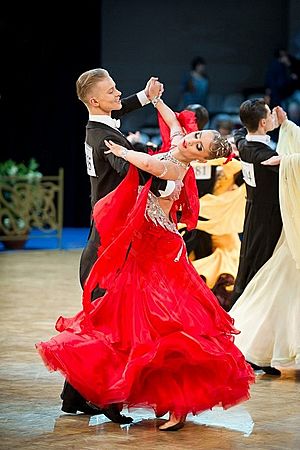Foxtrot facts for kids
The Foxtrot is a smooth and elegant ballroom dance. It started from American band music and is now a popular international standard dance. You'll see the Foxtrot in all major ballroom dance competitions around the world.
Contents
History of the Foxtrot Dance
Many popular ballroom dances came from other countries. For example, the Waltz came from Germany and the Tango from Argentina. English dancers then changed and improved them into the styles we know today. The Foxtrot and Quickstep were especially shaped by American music.
How American Music Influenced Foxtrot
The Boston Dance
Around 1903, an American dance called the Boston arrived in England. This dance used slow, gliding steps. In the Foxtrot, dancers slide their feet past each other instead of bringing them together. The Boston was likely the first dance to use this special foot movement. It was also the first ballroom dance where feet were kept parallel.
The Boston dance became less popular after the First World War. Dance floors became too crowded. Also, new and exciting music from America started to arrive.
Ragtime and Jazz Music
Ragtime and jazz music became very popular in Europe. These new music styles brought many exciting 'craze' dances with them. After the war, big bands like Paul Whiteman's became famous. His bands played arranged jazz music and were very successful.
Popular 'Craze' Dances
Between 1910 and 1920, America became very excited about dancing. Over one hundred new dances appeared in ballrooms! Some examples include The Shimmy, The Turkey Trot, and The Bunny Hug. Most of these dances started in the black community in the United States. Some of them later became popular in white society too.
The English Contribution to Foxtrot
In the 1920s, English dance teachers wanted to find new ways to dance to the modern music. They decided that different music speeds needed different dances. So, the Foxtrot, which started as a mid-speed dance, slowly split into two dances. These were the Slow Foxtrot and the Quick Foxtrot.
Over time, these two dances developed different styles. The Quickstep, as it was soon called, was influenced by the Charleston. The Slow Foxtrot took ideas from the Boston dance. The bouncy rhythm you hear in the Quickstep today shows its roots in ragtime music.
Origin of the Foxtrot Name
Many people believe the Foxtrot got its name from a vaudeville actor named Harry Fox. However, the exact story is not fully clear. The dance first appeared in 1914. A famous husband and wife dance team, Vernon and Irene Castle, quickly noticed it. They helped give the dance its graceful and stylish look.
The song Memphis Blues by W.C. Handy is also said to have inspired the Foxtrot. The Castles' music director would play this song during breaks. The Castles loved the rhythm. They first called a similar dance the 'Bunny Hug' in a magazine. But while traveling, they sent a message to the magazine to change the name to 'Foxtrot'.
Foxtrot Dance Steps
Here are some of the steps used in the International or English style Foxtrot:
Basic Figures
- Three Step
- Feather Step
- Natural Turn
- Reverse Turn
- Closed Impetus
Standard Figures
- Natural Weave
- Basic Weave
- Closed Telemark
- Open Telemark
- Hover Feather
- Hover Telemark
- Hover Cross
- Open Impetus
- Wave
See also
 In Spanish: Foxtrot (baile) para niños
In Spanish: Foxtrot (baile) para niños


